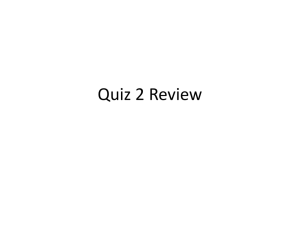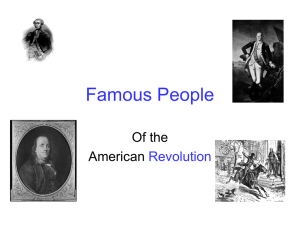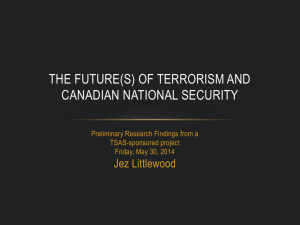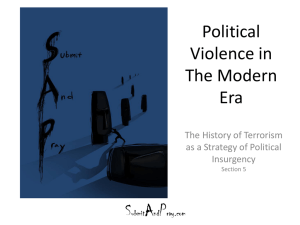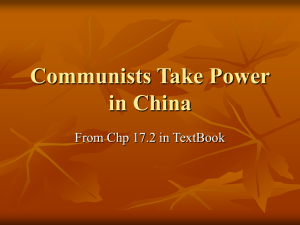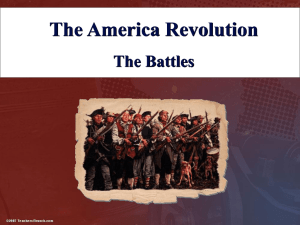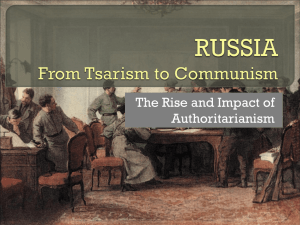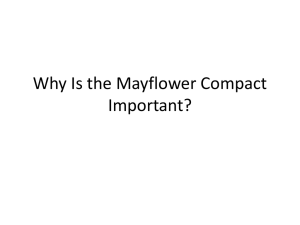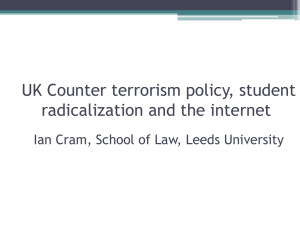11_LeftWing - James JF Forest
advertisement
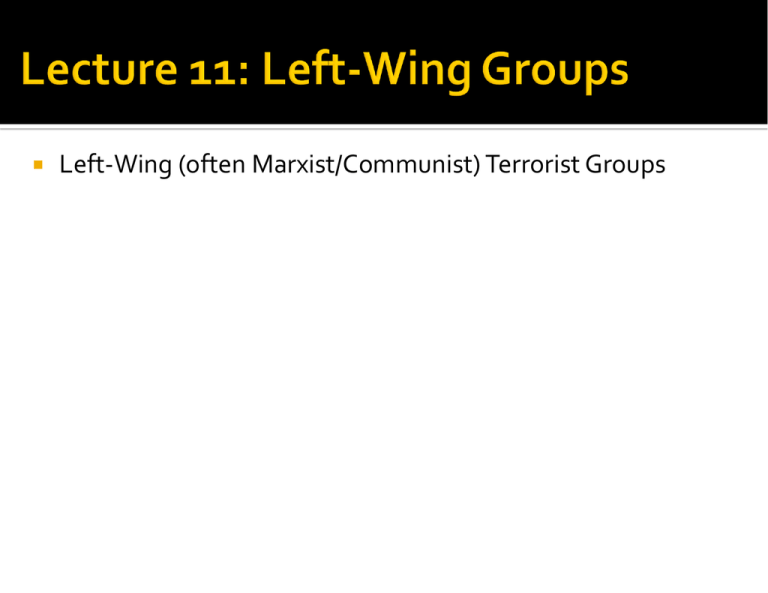
Left-Wing (often Marxist/Communist) Terrorist Groups Cold War, Soviet commitment to spread of Communism De-colonization conflicts, including: French in Southeast Asia, Algeria U.S. in Southeast Asia British in East Africa Successful revolutionary movements in Asia, Latin America, etc. Mao Tse-tung and China in the 1940s Ho Chi Minh and Vietnam in the 1950s, 1960s, & 1970s Mao Tse-Tung Fidel Castro and Cuba in the late 1950s/early 1960s Latin American civil wars South Africa, Palestinian territories, Northern Ireland conflicts Modern European terrorism emerged in the 1960s as an extreme reflection of left-wing activism Wretched of the Earth (1961): Western powers have dehumanized non-Western people by destroying their cultures and replacing them with Western values The masses suffer a perpetual identity crisis, forced to deny their heritage. They can follow only one course of action: guerilla warfare revolution (achieving freedom is inherently violent) Terrorism had a specific purpose: to terrorize Westerners and their followers into submission Urban terror was to create mayhem, and all terrorism was to be excessively brutal to communicate fear. Fanon’s guerrilla model thus uses terrorism as a strategy and deviates from typical guerrillas who try to build a military force Argentine Marxist; traveled throughout Latin America and became convinced that the region’s economic problems were caused by capitalism, neocolonialism and imperialism, with the only remedy being world revolution. Published his lessons learned from success in Cuba (w/Castro) of ousting the Batista regime Foco theory of revolution: “Vanguardism” by cadres of small, fast-moving paramilitary groups can provide a focus for popular discontent against a sitting regime, and thereby lead a general insurrection. Popular forces can win a war against the army Immediate Action: It is not necessary to wait until all conditions for making revolution exist; the insurrection can create them The countryside is the basic area for armed fighting; must mobilize and launch attacks from rural areas Authored Liberation of Brazil, and Mini-Manual of the Urban Guerilla Practical guides for terrorism The basis of revolution is violence All violence could be urban-based and controlled by a small group of urban guerillas Two phases of Urban Guerilla model: 1) violence, and 2) give that violence meaning The terror campaign must be accompanied by a mass movement of revolutionary sympathizers, to provide peripheral support for terrorists A campaign of revolutionary terrorism in an urban setting can be used to destabilize government power A terrorist campaign will force the government to reveal that repressive nature, thereby alienating the public Governmental repression is the goal of terrorism at this stage. Strategy: Armed violence against the capitalist state; Provoke government into repressive response, antagonize population Common Targets Common Tactics Symbolic targets Policemen Lawyers Judges University professors Politicians Union leaders Industrialists Military/security facilities Armed robberies Operations against the military (snipers, planting mines, etc.) Kidnapping (for attention and coercive bargaining) Selective assassination (snipers, letter bombs, etc.) Indiscriminate attacks in public places Lots o’ bombings . . . Prominent role of academics, intellectual elites Sendero Luminoso: University of San Cristobal de Huamanga (Abimael Guzman) Red Brigades: University of Trento (Renato Curcio, Mara Cagol) Red Army Faction: Free University of Berlin (Andreas Baader, Ulrike Meinhof) 17 November: Athens Polytechnic Common reasons for the decline of left-wing terror groups: Intellectual elites who controlled the movement got older and lost their ability to connect with increasingly younger student activist audiences. Impatient leaders, members led to mistakes, counterproductive violence Alienation of target audiences (instead of mobilization) undermined political objectives Left-wing movements became more specific, focusing not only on certain political behavior, but on particular causes (e.g., ELF, ALF, Monkey Wrench Gang – spiking trees, arson attacks, lumber mills, etc.) Government actions and improved police tactics certainly contributed to the decline of left-wing terrorism in the U.S. and Europe Focused on fundamental, systemic change • Groups influenced by revolutionaries in other countries • Domestic, Marxist, some state support • Armed violence against the capitalist state; provoke overreaction Mao TseTung Ernesto “Che” Geuvara Frantz Fanon Carlos Marighella Mao: the guerilla should be likened to a fish in the sea - People’s War Che: a small dedicated cadre of fighters can create the conditions for popular revolution (cult of martyrs?) Fanon: political violence is a necessary instrument of liberation Marighella: urban violence will “systematically inflict damage on the authorities… (and)…the people who dominate …and exercise power” Action Directe (France) Sendero Luminoso (Peru) 17 November (Greece) Weather Underground (United States) Tupamaros (Uruguay) Japanese Red Army Red Army Faction (Germany) Red Brigades (Italy) Mujahedin-e-Khalq (Iran) Popular Revolutionary Army (Mexico) Nepal Insurgents (Maoists) United Freedom Front (United States) 25 April Movement (Portugal) Revolutionary Movement of Tupac Amaru (Peru) Irish Nationalist Liberation Army (IRSP militants) Revolutionary Armed Forces of Colombia (Colombia) May 19 Communist Organization (United States) Evan Mecham Eco-Terrorist International Conspiracy (United States) Others . . . West German leftist group founded in 1968 and active until 1998; most core members were university students, led by Andreas Baader and Ulrike Meinhof Lots of bombings and armed assaults against police, U.S. military personnel and journalists Assassinated several important individuals, including Germany’s Supreme Court President Gunter von Drenkman (1974) Airplane Hijackings and Kidnappings (e.g., Hans Martin Schleyer) not for ransom but to coerce release of group members from prison Italian Marxist-Leninist terrorist group founded in Milan in 1970 and active until the late 1980s Much larger than RAF (up to 1,500 by the end of 1970s) Centralized structure with at least 6 local “columns” (cells or branches) Mostly bombings, kidnappings to demand ransoms and the release of its comrades from prison Aldo Moro, former Prime Minister U.S. General James Dozier, Deputy Chief of Staff at NATO’s Southern European land forces French group, established in 1979; active less than 10 years Major bombings, 1982 attack on the World Bank European Headquarters 1984 attack on the European Space Agency 1985 attack at the officers’ club at the Rhein-Main U.S. Air Force Base Assassinations French General Rene Audran (1985) George Besse, the Chairman of Reneault (1986) U.S. group; extreme militant splinter of Students for a Democratic Society (anti-Vietnam War movement on college & university campuses) Originally called “Weathermen” but later changed their name to The Weather Underground Organization (WUO) Robberies, jailbreaks and nearly two dozen bombings throughout the early and mid-1970s New York City Police (1970) National Guard Armory (1970) U.S. Senate buiding (1971) Pentagon (1972) U.S. State Department (1975) La Violencia, the 1948-1958 Colombian civil war 1964, FARC launched as armed wing of Colombian Communist Party 1960s and 1970s, collected revolutionary taxes from landowners and peasants to raise money Imposed taxes on narco-traffickers in exchange for the use of land for cultivation, labs, landing strips Manufactured own military equipment and weapons, including mortars and landmines Today its violent activities revolve much more around the fight to maintain control over part of Colombia’s drug trade Maoist group established in 1969 as militant outgrowth of the Peruvian Communist movement Occupied villages, established revolutionary governments, and trained members in guerilla strategy and the use of firearms and explosives Car bombings, kidnappings and political assassinations; attacked the U.S. Embassy, Peruvian political officials, schools, police stations, middle class neighborhoods, and Lima’s banking center Imposed “taxes” on businesses and individuals in occupied villages; Became increasingly involved in the Peruvian cocaine trade in the Upper Huallaga Valley aka “Naxalites”, established 2004 Seeks complete overhaul of the Indian government in order to establish a Communist society Imposition of “taxes” on villages and village officials Estimated over 10,000 fighters World’s #1 kidnapping group in 2010 Ideological resonance among poor, rural indigenous communities in northeast India Communist Party of Nepal Purbo Banglar Communist Party of Bangladesh (PBCP) Zapatista Army of National Liberation (EZLN) Sandinista National Liberation Front (FSLN) Farabundo Marti National Liberation Front (FMLN) Popular Front for the Liberation of Palestine (PFLP) Japanese Red Army Irish National Liberation Army For more, see: Global Terrorism Database Profiles http://www.start.umd.edu/start/data_collections/tops/ National Counterterrorism Center Profiles http://www.nctc.gov/site/profiles/index.html Most left-wing groups failed to achieve their objectives Some transformed into legitimate participants in the official political processes of their countries Others moved away from emphasis on left-wing Marxist ideology and more toward criminal objectives
